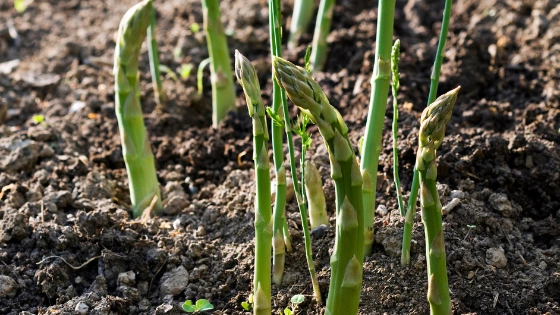 The following is a guest blog from Erin J. Dingle from the Frederick County Master Gardener Program. Master Gardeners are volunteers who combine their love of plants, people and the environment to help provide solutions in their communities. In 2021, Master Gardener Programs offered nearly 1,000 classes and over 300 Ask a Master Gardener Plant Clinics in collaboration with food banks, nature centers, schools, libraries, garden clubs, non-profits, hospitals, nursing homes and community gardens. In this guest blog, Erin explains how you can grow asparagus in your own garden just like the professionals, farmers that is.
The following is a guest blog from Erin J. Dingle from the Frederick County Master Gardener Program. Master Gardeners are volunteers who combine their love of plants, people and the environment to help provide solutions in their communities. In 2021, Master Gardener Programs offered nearly 1,000 classes and over 300 Ask a Master Gardener Plant Clinics in collaboration with food banks, nature centers, schools, libraries, garden clubs, non-profits, hospitals, nursing homes and community gardens. In this guest blog, Erin explains how you can grow asparagus in your own garden just like the professionals, farmers that is.
Asparagus is the magical vegetable of spring and the harvest in Maryland just finished up a few weeks ago. Those wise gardeners who planted their patch three or more years ago were able to enjoy a truly wonderful garden product throughout late April and early May. At the local grocery store you can expect to pay dearly for fresh asparagus. It’s an elegant yet simple vegetable that adds a touch of class to any menu. Steamed with a sauce, baked in a little butter, grilled with a balsamic marinade, asparagus is just one of those vegetables where the word ‘fresh’ is critically important and cutting right from your own patch is about as fresh as asparagus comes.
Take heart if you don’t already have an asparagus garden because if you have patience, a small plot of earth and the desire to follow these instructions, it won’t be long before you too can brag to all of your friends about the fresh asparagus you’re fixing for breakfast, lunch or dinner. As a perennial vegetable, you’ll be able to look forward to its’ early appearance each spring once you’ve planted it.
The first thing to do is prepare a bed, remembering that asparagus is usually grown by itself. Because it imperative to leave the beautiful ferny foliage stand all summer and fall when it goes dormant, asparagus plants will shade plants next to it so plant it next to your garden but by itself. Choosing a sunny site, decide how big to make your asparagus bed. The size of the bed is at your discretion and depends on how many plants you want to put in. Each mature plant may send up 15 to 20 spears when it matures. You may want to start with about 20 plants planted about a foot from each other. You can always add more plants to the garden if you feel you need more.
Double dig and remove all weeds. Once your plants are established, you don’t want weeds getting the best of them. It is very important to enrich the plot with rotted leaves, compost or manure. You can start this process now and just keep adding materials until you plant next spring. Asparagus loves rich organic soil and a bed can produce for decades so care at the beginning will pay off in quality and quantity.
Asparagus, a member of the lily family, is just about impossible to grow from seed, so the home gardener should purchase 1-year-old asparagus crowns, which are the roots of the plant. Look for bundles with 10-15 roots that are dormant (showing no green shoots) and that look firm and fresh, not limp. The bundles can be obtained from a local plant store, nurseries, mail order catalogs or hardware store. Plant as soon as possible after purchasing.
When ready to plant, dig a trench of about 6 inches and set the crowns in the trench about a foot away from each other. Cover with about 2 inches of soil and gradually work soil into the trench throughout the first season as you see the plants begin to grow, usually in about two weeks. You don’t want to fill too quickly because you’ll risk stifling the plants. Keep adding soil throughout the first growing season until the trench is level. Water weekly if it doesn’t rain and cut no asparagus shoots the first year to allow the foliage to grow, yellow and die on its own. This creates the food for the roots. At the end of winter, it is recommended that you cut the foliage and burn it or haul it away because it could harbor eggs of the asparagus beetle. The second year, cut sparingly only those stalks as big as your finger. Keep watering, waiting and mulching with manure and compost.
The third year is the magical year that you’ll be enjoying asparagus from your garden to the table. When the stalks are about 6 inches high, just snap where they begin to be tender and enjoy. If you use a knife, you risk accidentally cutting immature spears. When you stop harvesting depends on the weather but six to eight weeks is a normal growing season. Allow a certain number of shoots from each plant to make it to full growth to manufacture food for next year’s harvest.
Clean cultivation encourages vigorous growth and it behooves the gardener to keep the asparagus bed clean from the start, hand digging weeds and taking care not disturb the roots. An application of manure and other organic material once a year would be an excellent fertilizer applied right after the cutting season.
Asparagus rust is a disease that was once common but most varieties sold now are rust resistant. Asparagus beetles are the chief enemies of the crop. Pick the beetles off when you see them and remember that a well-cared-for bed will prevent them, especially if you burn the dead foliage in the winter.
Hungry for more? Not ready to grow your own veggies? Visit a local farmer’s market. Read articles from other master gardeners. Read these spring lawn tips.
Love to garden? Consider becoming a master gardener to learn new techniques, hone your gardening skills and meet new people who enjoy gardening as much as you do!
Sign up for our newsletter and find us on Facebook, Twitter and Instagram.

